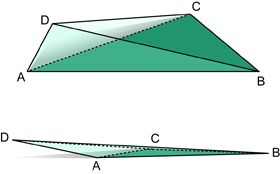Any tetrahedral elements in which the angle between one surface and an adjacent surface is either very close to 0 or 180 degrees is said to be a tetra with extreme angles between faces.
Tetrahedron (tetra) with extreme interfacial angles are detected with the Mesh Repair Wizard:  ().
().
Description
The mathematical analysis of a model is based on the assumption that the mesh is composed of uniform, equilateral tetra. In practice the mesh will be comprised of tetras that range form the ideal equilateral tetra to the extremely distorted tetra with the potential to significantly effect the results. As such it is important to reduce the number of distorted tetra as far as practical. Aspect Ratio is the most common method used to measure the mesh quality. Other methods are Internal Long Edges and Tetra with High Aspect Ratio.
In the upper diagram, if nodes A and D are close together, the angle between face ABC and BCD will be close to zero. This tetra would have a very small interfacial angle. For diagnostic purposes, a default threshold value of less than 2 degrees is considered an extreme value.
Alternatively, a flat tetra would result, if, in the lower diagram, the angle between face ABC and ACD was close to 180 degrees. This tetra would be considered to have an extremely large interfacial angle. For diagnostic purposes, the default threshold value is 178 degrees.

It is not compulsory to rectify these problems, and the process can be very slow if thousands of tetras are to be fixed.
Impact on the analysis
Tetra with extreme interfacial angles can cause distorted results. Temperature at a node, for example, takes into account the temperature of all nodes it is attached to. Assume flow is from right to left in the diagram above and the aim is to predict the temperature at node D. Because of the larger distance between B and D in the bottom diagram, the contribution of the temperature at B will be overstated in any calculations.
Recommended action
The Mesh Repair Wizard can rectify most of this problem:  (). If there are thousands of tetra to be repaired, this may take some time.
(). If there are thousands of tetra to be repaired, this may take some time.